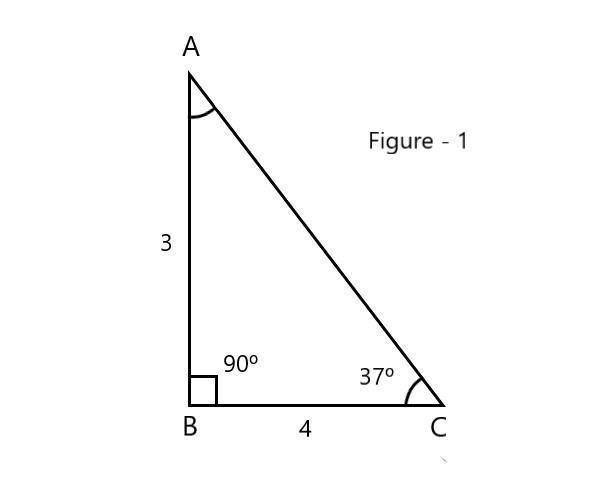Question
Question: How to find the value of \[\sin {{37}^{\circ }}\] and \[{{24}^{\circ }}\]...
How to find the value of sin37∘ and 24∘
Solution
To find the value of sin37∘ we will apply angle sum property and find out the value of ∠A and then we will assume the values of sides AB and BC and then apply Pythagoras theorem and we can find the value of sin37∘ . For sin24∘ we will use a different formula of sinθ Then we will solve each trigonometric function to get the required solution.
Complete step-by-step solution:
The word Trigonometry is derived from the Greek word trigon and metron. Here trigon means figures with three angles and metron means measurement. That is the meaning of the word Trigonometry is a measurement of triangles. In the modern age Trigonometry has broad based meaning. In simple words we define it as that branch of mathematics which deals with the measurement of angles and the problems allied with angles.
Currently trigonometry is used in many areas such as the science of seismology, designing electric circuits, predicting the heights of tides in the ocean, analyzing the musical tone and in many other areas.
We know that the angle between 0∘ and 90∘ is called acute angle. Further the angle of 90∘ is called right angle and the angle lies between 90∘ and 180∘ is called obtuse angle.
A series of real valued functions, defined as the ratio of the sides of a triangle is called a Trigonometric Function.
Trigonometric functions are also known as the circular functions.The basic trigonometric functions are sine, cosine, tangent, cotangent, secant and cosecant. The angles of sine, cosine, and tangent are the primary classification of functions of trigonometry. And the three functions which are cotangent, secant and cosecant can be derived from the primary functions.
Now according to the question to find the value of sin37∘
We know that 37∘<90∘ hence 37∘ is an acute angle

Now from △ABC in figure (1) , ∠C is 37∘ and ∠B=90∘
By angle sum property:
⇒∠A+∠B+∠C=180o
⇒∠A+90∘+37∘=180o
⇒∠A+127∘=180o
⇒∠A=180o−127∘
∴∠A=53∘
Let AB=3 units and BC=4 units
Now by Pythagoras theorem:
hypotenuse2=perpendicular2+base2
According to figure (1)
⇒AC2=AB2+BC2
⇒AC2=42+32
⇒AC2=16+9
⇒AC2=25
⇒AC=25
We know that
sinθ=hypotenuseperpendicular
Hence,
sin37∘=ACAB
∴sin37∘=53
Now to find the value of sin24∘
⇒sin24∘=sin(60∘−36∘)
Apply the formula sin(A−B)=sinAcosB−cosAsinB
Where A=60∘ and B=36∘
⇒sin(60∘−36∘)=sin60∘⋅cos36∘−cos60∘⋅sin36∘
We know that
sin60∘=23 , cos60∘=21 , cos36∘=45+1 , sin36∘=410−25
Put this value in above equation we get ,
⇒sin(60∘−36∘)=[23⋅(45+1)−21⋅(410−25)]
⇒sin(60∘−36∘)=83+15−810−25
⇒sin(60∘−36∘)=83+15−10−25
Hence
sin24∘=83+15−10−25
Note: We must keep one thing in mind that sinθ is not the same as sin×θ because it represents a ratio, not a product and this is true for all the trigonometric ratios. Any trigonometric function of angle θ∘ is equal to the same trigonometric function of any angle n×360∘+θ, where n is any integer.
